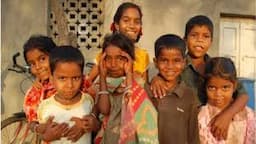The Gujarat Health Department reported 13 new suspected cases of the Chandipura virus on July 21, with five fatalities. The state's overall number of confirmed and suspected illnesses now stands at 84, including 32 deaths.
Since June 2024, 78 cases of acute encephalitis syndrome (AES), which is inflammation of the brain caused by an infection, have been reported in Gujarat, Rajasthan, and Madhya Pradesh, with 28 deaths.

Amid a possible epidemic of the Chandipura virus, at least nine individuals in Gujarat, five of whom died, tested positive for the fatal infection.Two new suspected cases have been recorded each in Ahmedabad, Aravalli, and Banaskantha, whereas Surendranagar, Gandhinagar, Kheda, Mehsana, Narmada, Vadodara, and Rajkot have reported one case each.The state health department reported five suspected deaths caused by the Chandipura virus, one each from Mahisagar, Kheda, and Vadodara, and two from Banaskantha.
According to data revealed by the Union Ministry of Health and Family Welfare, 75 AES instances have been reported from Gujarat, two from Rajasthan, and one from Madhya Pradesh. The National Institute of Virology in Pune analyzed 76 samples and found Chandipura virus in nine, all from Gujarat. According to the Union Ministry, a team of specialists who analyzed the AES cases in the three states decided that infectious agents contributed to only a tiny number of them and underlined the necessity for comprehensive "epidemiological, environmental, and entomological (insect) studies."
This will aid in understanding the reasons that have contributed to the outbreak and will halt the vector's proliferation, preventing new infections. According to the statement, a multidisciplinary central team consisting of the National Centre for Disease Control (NCDC), the Indian Council of Medical Research (ICMR), and the Department of Animal Husbandry and Dairying (DAHD) has been dispatched to assist Gujarat with the investigations.
The panel included Dr. Atul Goel, Directorate General of Health Services and Director of NCDC; experts from All India Institute of Medical Sciences (AIIMS), Kalawati Saran Children's Hospital, and the National Institute of Mental Health and Neurosciences (NIMHANS); and officials from the central and state surveillance units.
According to Dr. PK Singh, Chief District Health Officer (CDHO) of Gujarat's Rajkot hospital, this year's outbreak may be caused by sandfly migration. "Sandflies are often nonexistent in Saurashtra, but migration, combined with environmental conditions associated with the start of the monsoon, may be encouraging their spread. It's possible that the weather caused this," Singh said.
"The government has implemented a number of measures to minimize viral infections spread by vectors such as mosquitoes, ticks, and sandflies," stated the state health department.
The National Institute of Virology (NIV) in Pune confirmed nine cases of the Chandipura virus in Gujarat on July 21.
The health department reported that samples from all suspected cases had been forwarded to the NIV for testing. Following the first Chandipura virus fatality in Gujarat on July 17, the state health authority issued directions requiring daily surveillance and supervision at the local level to detect potential infections and manage the disease.
As previously indicated, health department staff conducted surveillance in around 19,000 households and applied powder to 116,000 houses in the concerned areas. Each occurrence is being extensively probed by quick response teams, and it is recommended that the public wear personal protective gear.
According to Gujarat Health Minister Rushikesh Patel, up to 50 cases of the Chandipura virus have been detected across the state, with 16 people dying as a result of the suspected infection. He claimed 14 cases of Chandipura virus have been recorded in Himmatpur, with seven patients admitted.
"Three cases of the Chandipura virus have emerged from different states. 50 cases of Chandipura virus have been reported throughout the state, and 16 people have died," Patel added.
He said that information about this had been sent to every community and community health center. The Chief Minister also held meetings with collectors, the Chief District Health Officer (CDHO), and medical colleges.
"In Gujarat, indications of the Chandipura virus were discovered in kids, which has raised considerable concern. Seven cases were submitted to Pune for lab testing, and only one instance of the Chandipura virus was discovered. All symptoms, including edema and diarrhea, are not caused only by the Chandipura virus. This could also be attributed to encephalitis. Important information regarding the virus has been circulated throughout the entire state," he said.
Earlier, Chief Minister Bhupendra Patel examined the state's condition in the wake of the Chandipura virus and assessed the actions taken to control the epidemic. Patel and other senior officials also attended the meeting.
To examine district performance, CM spoke with the State Municipal Commissioners, District Collectors, District Development Officers, and Chief District Health Officers via videoconference.
To prevent the spread of the disease, the Chief Minister authorized officials to conduct a spraying campaign in the districts using Malathion powder. He also requested that officials provide immediate and intensive treatment to individuals with any type of fever.
To avert the outbreak, Gujarat's Health Minister proposed that grassroots workers such as Asha workers, Anganwadi workers, and nurses take action in rural communities.
Vesiculovirus chandipura, often known as Chandipura virus (CHPV), belongs to the Rhabdoviridae family. This virus, which was first isolated in 1965 in the Chandipura district of Maharashtra, India, is most known for causing acute encephalitis, a severe brain inflammation that primarily affects children.
Chandipura virus is named after the village of the same name in India's western state, Maharashtra's Nagpur region, where it was initially discovered.

The Chandipura virus is typically spread by vectors such as mosquitoes, ticks, and sandflies. The infection spreads when infected sandflies bite individuals and inject the virus into their bloodstream. Additional possible modes of transmission, though less common, include contact with bodily fluids from an infected person or animal.
The symptoms of Chandipura virus infection usually appear suddenly and might progress quickly. Common symptoms include a high fever, headache, and vomiting. In severe circumstances, individuals can fall into a coma. The virus primarily affects youngsters and can spread quickly, making early discovery and treatment critical.
During the 2003–2004 epidemics in Central India, case fatality rates reached between 56% and 75% in Andhra Pradesh and Gujarat, with patients exhibiting typical encephalitic symptoms.















